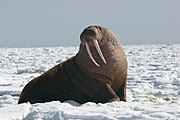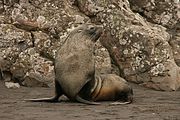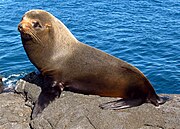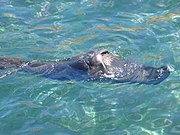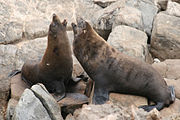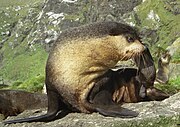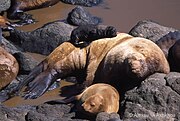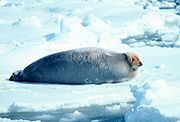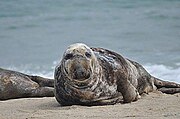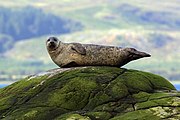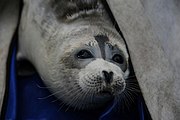Pinnipedia is an infraorder of mammals in the order Carnivora, composed of seals, sea lions, and the walrus. A member of this group is called a pinniped or a seal.[a] They are widespread throughout the ocean and some larger lakes, primarily in colder waters. Pinnipeds range in size from the 1.1 m (3 ft 7 in) and 50 kg (110 lb) Baikal seal to the 6 m (20 ft) and 3,700 kg (8,200 lb) male southern elephant seal, which is also the largest member of Carnivora.[1] Several species exhibit sexual dimorphism, such as the southern elephant seal, where the males can be more than three times as long and six times as massive as the females, or the Ross seal, which has females typically larger than the males. Four seal species are estimated to have over one million members, while six are classified as endangered with population counts as low as 600, and two, the Caribbean monk seal and the Japanese sea lion, went extinct in the 20th century.
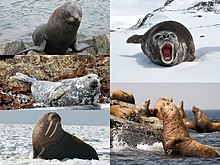
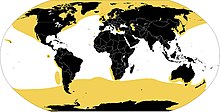
The 34 extant species of Pinnipedia are split into 22 genera within 3 families: Odobenidae, comprising the walrus; Otariidae, the eared seals, split between the sea lions and fur seals; and Phocidae, the earless or true seals. Odobenidae and Otariidae are combined into the superfamily Otarioidea, with Phocidae in Phocoidea. Extinct species have also been placed into the three extant families, as well as the extinct family Desmatophocidae, though most extinct species have not been categorized into a subfamily. Nearly one hundred extinct Pinnipedia species have been discovered, though due to ongoing research and discoveries the exact number and categorization is not fixed.
Conventions
| Conservation status | |
|---|---|
| EX | Extinct (2 species) |
| EW | Extinct in the wild (0 species) |
| CR | Critically Endangered (0 species) |
| EN | Endangered (6 species) |
| VU | Vulnerable (2 species) |
| NT | Near threatened (1 species) |
| LC | Least concern (23 species) |
Conservation status codes listed follow the International Union for Conservation of Nature (IUCN) Red List of Threatened Species. Range maps are provided wherever possible; if a range map is not available, a description of the pinniped's range is provided. Ranges are based on the IUCN Red List for that species unless otherwise noted. All extinct species or subspecies listed alongside extant species went extinct after 1500 CE, and are indicated by a dagger symbol "†".
Classification
The infraorder Pinnipedia consists of 3 families containing 34 extant species belonging to 22 genera and divided into 48 extant subspecies, as well the extinct Caribbean monk seal and Japanese sea lion species, which are the only pinniped species to go extinct since prehistoric times. This does not include hybrid species or extinct prehistoric species.
- Superfamily Otarioidea
- Family Odobenidae
- Genus Odobenus: 1 species
- Family Otariidae
- Genus Arctocephalus: 8 species
- Genus Callorhinus: 1 species
- Genus Eumetopias: 1 species
- Genus Neophoca: 1 species
- Genus Otaria: 1 species
- Genus Phocarctos: 1 species
- Genus Zalophus: 3 species
- Family Odobenidae
- Superfamily Phocoidea
- Family Phocidae
- Genus Cystophora: 1 species
- Genus Erignathus: 1 species
- Genus Halichoerus: 1 species
- Genus Histriophoca: 1 species
- Genus Hydrurga: 1 species
- Genus Leptonychotes: 1 species
- Genus Lobodon: 1 species
- Genus Mirounga: 2 species
- Genus Monachus: 1 species
- Genus Neomonachus: 2 species
- Genus Ommatophoca: 1 species
- Genus Pagophilus: 1 species
- Genus Phoca: 2 species
- Genus Pusa: 3 species
- Family Phocidae
Pinnipeds
The following classification is based on the taxonomy described by Mammal Species of the World (2005), with augmentation by generally accepted proposals made since using molecular phylogenetic analysis. This includes splitting the monk seal genus Monachus into Monachus and Neomonachus, the reorganization of grey seal subspecies, and the removal of the Laptev walrus subspecies.[2][3][4]
Family Odobenidae
| Common name | Scientific name and subspecies | Range | Size and ecology | IUCN status and estimated population |
|---|---|---|---|---|
| Walrus | O. rosmarus (Linnaeus, 1758) Two subspecies
| Arctic Ocean and subarctic seas | Size: Male: 270–356 cm (106–140 in) long; 800–1,700 kg (1,764–3,748 lb) Female: 225–312 cm (89–123 in) long; 400–1,250 kg (882–2,756 lb)[5] Habitat: Neritic marine, oceanic marine, intertidal marine, coastal marine, and other[6] Diet: Bivalve mollusks, as well as other invertebrates, slow-moving fish, and occasionally birds, seals, and other marine mammals[6] | VU
|
Family Otariidae
| Common name | Scientific name and subspecies | Range | Size and ecology | IUCN status and estimated population |
|---|---|---|---|---|
| Antarctic fur seal | A. gazella (Peters, 1875) | Subantarctic islands | Size: Male: 180 cm (71 in) long; 130–200 kg (287–441 lb) Female: 120–140 cm (47–55 in) long; 22–50 kg (49–110 lb)[7] Habitat: Neritic marine, oceanic marine, intertidal marine, and coastal marine[7] Diet: Krill, cephalopods, fish, and penguins[7] | LC
|
| Brown fur seal | A. pusillus (Schreber, 1775) Two subspecies
| Southern African and Australian coasts (dark blue indicates breeding grounds) | Size: Male: 201–227 cm (79–89 in) long; 218–360 kg (481–794 lb) Female: 136–171 cm (54–67 in) long; 41–113 kg (90–249 lb)[8] Habitat: Neritic marine, oceanic marine, intertidal marine, and coastal marine[8] Diet: A wide variety of fish, cephalopods, and crustaceans, and sometimes African penguins and other seabirds[8] | LC
|
| Galápagos fur seal | A. galapagoensis Heller, 1904 | Galápagos Islands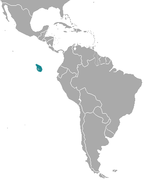 | Size: Male: 150–160 cm (59–63 in) long; 60–68 kg (132–150 lb) Female: 110–130 cm (43–51 in) long; 27–33 kg (60–73 lb)[9] Habitat: Neritic marine, oceanic marine, intertidal marine, and coastal marine[9] Diet: Small squids and a variety of fish[9] | EN
|
| Guadalupe fur seal | A. townsendi Merriam, 1897 | Islands off of the southern Pacific coast of North America (dark blue indicates breeding grounds)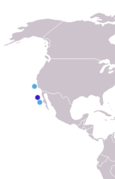 | Size: Male: 180 cm (71 in) long; 160–170 kg (353–375 lb) Female: 148 cm (58 in) long; 49 kg (108 lb)[10] Habitat: Neritic marine, oceanic marine, intertidal marine, and coastal marine[10] Diet: Squid, as well as fish[10] | LC
|
| Juan Fernández fur seal | A. philippii (Peters, 1866) | Islands off of the Pacific coast of South America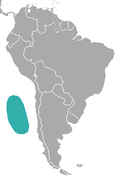 | Size: Male: 150–200 cm (59–79 in) long; 140 kg (309 lb) Female: 140 cm (55 in) long; 50 kg (110 lb)[11] Habitat: Neritic marine, oceanic marine, intertidal marine, and coastal marine[12] Diet: Lanternfish, as well as a narrow range of fish from the Scomberesocidae, Carangidae, Engraulidae, and Bathylagidae families, and cephalopods[12] | LC
|
| New Zealand fur seal | A. forsteri (Lesson, 1828) | Southern Australian and New Zealand coasts | Size: Male: 150–250 cm (59–98 in) long; 120–180 kg (265–397 lb) Female: 100–150 cm (39–59 in) long; 30–50 kg (66–110 lb)[13] Habitat: Forest, shrubland, neritic marine, oceanic marine, intertidal marine, and coastal marine[14] Diet: A wide variety of cephalopods, fish, and birds[14] | LC
|
| South American fur seal | A. australis (Zimmermann, 1783) Two subspecies
| Southern South American coasts | Size: Male: 200 cm (79 in) long; 90–200 kg (198–441 lb) Female: 140 cm (55 in) long; 60 kg (132 lb)[15] Habitat: Neritic marine, oceanic marine, intertidal marine, and coastal marine[15] Diet: Pelagic fish, demersal fish, and cephalopods[15] | LC
|
| Subantarctic fur seal | A. tropicalis (Gray, 1872) | Southern parts of the Indian, Pacific, and Atlantic Oceans | Size: Male: 180 cm (71 in) long; 70–165 kg (154–364 lb) Female: 119–152 cm (47–60 in) long; 25–67 kg (55–148 lb)[16] Habitat: Neritic marine, oceanic marine, intertidal marine, and coastal marine[16] Diet: Lanternfish, cod icefish, and cephalopods, as well as crustaceans and rockhopper penguins[16] | LC
|
| Common name | Scientific name and subspecies | Range | Size and ecology | IUCN status and estimated population |
|---|---|---|---|---|
| Northern fur seal | C. ursinus (Linnaeus, 1758) | Northern Pacific Ocean (dark blue indicates breeding grounds) | Size: Male: 213 cm (84 in) long; 180–275 kg (397–606 lb) Female: 142 cm (56 in) long; 40–50 kg (88–110 lb)[17] Habitat: Neritic marine, oceanic marine, intertidal marine, and coastal marine[17] Diet: A variety of epipelagic and vertically migrating mesopelagic fish and squid[17] | VU
|
| Common name | Scientific name and subspecies | Range | Size and ecology | IUCN status and estimated population |
|---|---|---|---|---|
| Steller sea lion | E. jubatus (Schreber, 1776) | Northern Pacific Ocean (red indicates breeding grounds) | Size: Male: 300–340 cm (118–134 in) long; 1,120 kg (2,469 lb) Female: 230–290 cm (91–114 in) long; 350 kg (772 lb)[18] Habitat: Neritic marine, oceanic marine, intertidal marine, and coastal marine[19] Diet: A variety of fish and cephalopods, as well as northern fur seal, harbor seals, and ringed seals[19] | NT
|
| Common name | Scientific name and subspecies | Range | Size and ecology | IUCN status and estimated population |
|---|---|---|---|---|
| Australian sea lion | N. cinerea (Péron, 1816) | Southwestern Australian coast | Size: Male: 180–250 cm (71–98 in) long; 180–250 kg (397–551 lb) Female: 130–180 cm (51–71 in) long; 61–105 kg (134–231 lb)[20] Habitat: Neritic marine, oceanic marine, intertidal marine, and coastal marine[20] Diet: Cephalopods, fish, and crustaceans[20] | EN
|
| Common name | Scientific name and subspecies | Range | Size and ecology | IUCN status and estimated population |
|---|---|---|---|---|
| South American sea lion | O. flavescens (Shaw, 1800) | Southeastern and western South American coast and islands | Size: Male: 210–260 cm (83–102 in) long; 300–350 kg (661–772 lb) Female: 150–200 cm (59–79 in) long; 170 kg (375 lb)[21] Habitat: Inland wetlands, neritic marine, oceanic marine, intertidal marine, and coastal marine[21] Diet: A wide variety of benthic fish, pelagic fish, and invertebrates[21] | LC
|
| Common name | Scientific name and subspecies | Range | Size and ecology | IUCN status and estimated population |
|---|---|---|---|---|
| New Zealand sea lion | P. hookeri (Gray, 1844) | Southern New Zealand coast and islands | Size: Male: 210–270 cm (83–106 in) long; 300–450 kg (661–992 lb) Female: 180–200 cm (71–79 in) long; 90–165 kg (198–364 lb)[22] Habitat: Forest, shrubland, neritic marine, oceanic marine, intertidal marine, and coastal marine[22] Diet: A wide variety of fish, cephalopods, and crustaceans, as well as penguins[22] | EN
|
| Common name | Scientific name and subspecies | Range | Size and ecology | IUCN status and estimated population |
|---|---|---|---|---|
| California sea lion | Z. californianus (Lesson, 1828) | Pacific North American coast (dark blue indicates breeding grounds) | Size: 165–220 cm (65–87 in) long; 275–390 kg (606–860 lb)[23] Habitat: Neritic marine, oceanic marine, intertidal marine, and coastal marine[24] Diet: A variety of fish and squid[24] | LC
|
| Galápagos sea lion | Z. wollebaeki Sivertsen, 1953 | Galápagos Islands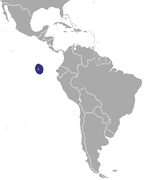 | Size: Male: 200–250 cm (79–98 in) long; 200–400 kg (441–882 lb) Female: 150–200 cm (59–79 in) long; 50–110 kg (110–243 lb)[25] Habitat: Neritic marine, oceanic marine, intertidal marine, and coastal marine[26] Diet: Sardines, as well as lanternfish, deep-sea smelt, and small squid[26] | EN
|
| Japanese sea lion† | Z. japonicus (Peters, 1866) | Sea of Japan | Size: Male: 230–250 cm (91–98 in) long; 450–560 kg (992–1,235 lb) Female: 160 cm (63 in) long[27] Habitat: Neritic marine, oceanic marine, intertidal marine, and coastal marine[27] Diet: Unknown; believed to be similar to California sea lions[27] | EX
|
Family Phocidae
| Common name | Scientific name and subspecies | Range | Size and ecology | IUCN status and estimated population |
|---|---|---|---|---|
| Hooded seal | C. cristata (Erxleben, 1777) | Central and western North Atlantic ocean (blue indicates breeding grounds)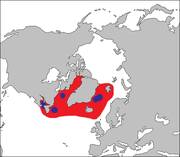 | Size: Male: 250–270 cm (98–106 in) long; 200–400 kg (441–882 lb) Female: 200–220 cm (79–87 in) long; 145–300 kg (320–661 lb)[5] Habitat: Neritic marine, oceanic marine, intertidal marine, and coastal marine[28] Diet: Fish and invertebrates throughout the water column[28] | VU
|
| Common name | Scientific name and subspecies | Range | Size and ecology | IUCN status and estimated population |
|---|---|---|---|---|
| Bearded seal | E. barbatus (Erxleben, 1777) Two subspecies
| Arctic ocean | Size: 200–260 cm (79–102 in) long; 200–360 kg (441–794 lb) tail[5] Habitat: Neritic marine, oceanic marine, and intertidal marine[29] Diet: Crabs, shrimp, clams, snails, benthic and demersal fish, and spoon worms[29] | LC
|
| Common name | Scientific name and subspecies | Range | Size and ecology | IUCN status and estimated population |
|---|---|---|---|---|
| Grey seal | H. grypus (Fabricius, 1791) Two subspecies
| Shores of the North Atlantic Ocean | Size: Male: 195–230 cm (77–91 in) long; 170–310 kg (375–683 lb) Female: 165–195 cm (65–77 in) long; 105–186 kg (231–410 lb)[5] Habitat: Neritic marine, oceanic marine, intertidal marine, and coastal marine[30] Diet: Benthic and demersal fish[30] | LC
|
| Common name | Scientific name and subspecies | Range | Size and ecology | IUCN status and estimated population |
|---|---|---|---|---|
| Ribbon seal | H. fasciata (Zimmermann, 1783) | Arctic and subarctic regions of the North Pacific Ocean (blue indicates reduced summer range) | Size: 165–175 cm (65–69 in) long; 72–90 kg (159–198 lb)[31] Habitat: Neritic marine and oceanic marine[32] Diet: Fish, crustaceans, and other invertebrates[32] | LC
|
| Common name | Scientific name and subspecies | Range | Size and ecology | IUCN status and estimated population |
|---|---|---|---|---|
| Leopard seal | H. leptonyx (Blainville, 1820) | Antarctic Ocean | Size: Male: 250–320 cm (98–126 in) long; 200–455 kg (441–1,003 lb) Female: 241–338 cm (95–133 in) long; 225–591 kg (496–1,303 lb)[5] Habitat: Neritic marine, oceanic marine, intertidal marine, and coastal marine[33] Diet: Krill, fish, squid, penguins, other seabirds, and juvenile seals[33] | LC
|
| Common name | Scientific name and subspecies | Range | Size and ecology | IUCN status and estimated population |
|---|---|---|---|---|
| Weddell seal | L. weddellii (Lesson, 1826) | Coastal Antarctic Ocean | Size: 280–330 cm (110–130 in) long; 400–600 kg (882–1,323 lb)[34] Habitat: Neritic marine, oceanic marine, intertidal marine, and coastal marine[35] Diet: Cod icefish, as well as Antarctic toothfish, lanternfish, and cephalopods[35] | LC
|
| Common name | Scientific name and subspecies | Range | Size and ecology | IUCN status and estimated population |
|---|---|---|---|---|
| Crabeater seal | L. carcinophaga (Hombron, Jacquinot, 1842) | Antarctic Ocean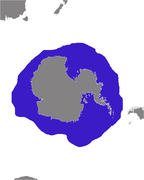 | Size: Male: 203–241 cm (80–95 in) long; 200–300 kg (441–661 lb) Female: 216–241 cm (85–95 in) long; 200–300 kg (441–661 lb)[5] Habitat: Neritic marine, oceanic marine, intertidal marine, and coastal marine[36] Diet: Antarctic krill, as well as fish and squid[36] | LC
|
| Common name | Scientific name and subspecies | Range | Size and ecology | IUCN status and estimated population |
|---|---|---|---|---|
| Northern elephant seal | M. angustirostris Gill, 1866 | Northeastern Pacific Ocean (red dots indicate breeding grounds)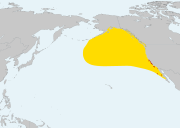 | Size: Male: 400–500 cm (157–197 in) long; 2,000–2,700 kg (4,409–5,952 lb) Female: 200–300 cm (79–118 in) long; 600–900 kg (1,323–1,984 lb)[5] Habitat: Neritic marine, oceanic marine, intertidal marine, and coastal marine[37] Diet: Squid, lanternfish, and other mesopelagic fish[37] | LC
|
| Southern elephant seal | M. leonina (Linnaeus, 1758) | Antarctic and subantarctic region | Size: Male: 450–600 cm (177–236 in) long; 1,500–3,700 kg (3,307–8,157 lb) Female: 200–300 cm (79–118 in) long; 400–600 kg (882–1,323 lb)[5] Habitat: Neritic marine, oceanic marine, intertidal marine, and coastal marine[38] Diet: Lanternfish, cod icefish, and squid[38] | LC
|
| Common name | Scientific name and subspecies | Range | Size and ecology | IUCN status and estimated population |
|---|---|---|---|---|
| Mediterranean monk seal | M. monachus (Hermann, 1779) | Scattered portions of the Mediterranean Sea | Size: 230–280 cm (91–110 in) long; 240–300 kg (529–661 lb)[39] Habitat: Neritic marine, oceanic marine, intertidal marine, and coastal marine[40] Diet: Benthic fish, pelagic fish, cephalopods, and lobsters[39][40] | VU
|
| Common name | Scientific name and subspecies | Range | Size and ecology | IUCN status and estimated population |
|---|---|---|---|---|
| Caribbean monk seal† | N. tropicalis (Gray, 1850) | Caribbean Sea | Size: 200–240 cm (79–94 in) long; 200 kg (441 lb)[5][39] Habitat: Neritic marine, oceanic marine, intertidal marine, and coastal marine[41] Diet: Believed to have eaten eels, lobsters, octopus, and coral reef fish[41] | EX
|
| Hawaiian monk seal | N. schauinslandi (Matschie, 1905) | Hawaiian islands | Size: 210–250 cm (83–98 in) long; 170–240 kg (375–529 lb)[39] Habitat: Neritic marine, oceanic marine, intertidal marine, and coastal marine[42] Diet: Benthic fish, pelagic fish, cephalopods, and lobsters[39][42] | EN
|
| Common name | Scientific name and subspecies | Range | Size and ecology | IUCN status and estimated population |
|---|---|---|---|---|
| Ross seal | O. rossii Gray, 1844 | Coastal Antarctic Ocean | Size: Male: 168–208 cm (66–82 in) long; 129–216 kg (284–476 lb) Female: 190–250 cm (75–98 in) long; 159–204 kg (351–450 lb)[5] Habitat: Neritic marine, oceanic marine, and coastal marine[43] Diet: Squid, as well as fish and krill[43] | LC
|
| Common name | Scientific name and subspecies | Range | Size and ecology | IUCN status and estimated population |
|---|---|---|---|---|
| Harp seal | P. groenlandicus (Erxleben, 1777) Two subspecies
| Northern Atlantic Ocean | Size: Male: 171–190 cm (67–75 in) long; 135 kg (298 lb) Female: 168–183 cm (66–72 in) long; 120 kg (265 lb)[44] Habitat: Neritic marine, oceanic marine, intertidal marine, and coastal marine[45] Diet: A wide variety of fish and invertebrates[45] | LC
|
| Common name | Scientific name and subspecies | Range | Size and ecology | IUCN status and estimated population |
|---|---|---|---|---|
| Spotted seal | P. largha Pallas, 1811 | Northern Pacific Ocean (dark areas indicate breeding grounds) | Size: Male: 161–176 cm (63–69 in) long; 85–110 kg (187–243 lb) Female: 151–169 cm (59–67 in) long; 65–115 kg (143–254 lb)[39] Habitat: Neritic marine, oceanic marine, intertidal marine, and coastal marine[46] Diet: A variety of fish, cephalopods, and crustaceans[46] | LC
|
| Harbor seal | P. vitulina Gray, 1864 Five subspecies
| Northern Hemisphere coastlines | Size: Male: 160–186 cm (63–73 in) long; 87–170 kg (192–375 lb) Female: 148–169 cm (58–67 in) long; 60–142 kg (132–313 lb)[39] Habitat: Neritic marine, oceanic marine, intertidal marine, and coastal marine[47] Diet: A wide variety of fish, cephalopods, and crustaceans[47] | LC
|
| Common name | Scientific name and subspecies | Range | Size and ecology | IUCN status and estimated population |
|---|---|---|---|---|
| Baikal seal | P. sibirica Gmelin, 1788 | Lake Baikal | Size: 110–140 cm (43–55 in) long; 50–130 kg (110–287 lb)[48] Habitat: Inland wetlands[48] Diet: Sculpin fish, as well as other fish[48] | LC
|
| Caspian seal | P. caspica Gmelin, 1788 | Caspian Sea | Size: 126–140 cm (50–55 in) long; 50–86 kg (110–190 lb)[49][50] Habitat: Inland wetlands[49] Diet: A variety of fish[49] | EN
|
| Ringed seal | P. hispida Schreber, 1775 Five subspecies
| Arctic Ocean | Size: 110–175 cm (43–69 in) long; 32–124 kg (71–273 lb)[51] Habitat: Inland wetlands, neritic marine, and oceanic marine[52] Diet: A variety of invertebrates and small fish[52] | LC
|
